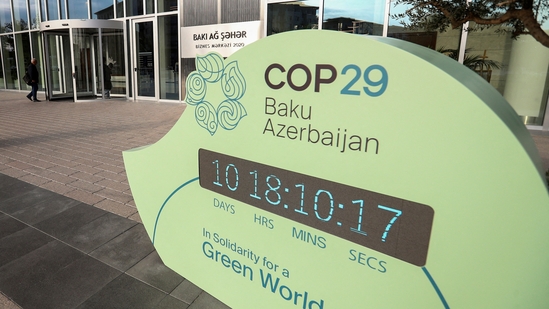Cause and Effect | 'No More Hot Air’: UNEP calls for urgent action to prevent climate catastrophe
As emissions climb to unprecedented levels, the UNEP’s latest report exposes a widening chasm between climate pledges and reality.
When COP28 closed in Abu Dhabi last December, with much fanfare, a statement by president Sultan Al-Jaber appeared lost in the din.

In his closing speech, Al-Jaber said: “We are what we do, not what we say.”
Strong words that now seem to haunt the world hurtling towards 3.1°C of warming by century's end, according to the latest Emissions Gap Report from the United Nations Environment Programme (UNEP).
The report titled “No more hot air…please!”, issued a central message: "Ambition means nothing without action."
This message cuts to the heart of the climate crisis, as despite decades of climate negotiations and commitments, global greenhouse gas emissions continue to rise, reaching an unprecedented 57.1 GtCO2e in 2023. This 1.3% increase from 2022 levels signals that the world is moving in precisely the wrong direction at a time when dramatic emissions reductions are desperately needed.
While countries have made increasingly ambitious pledges, the implementation gap between promises and actual policies continues to widen.
The report reveals that the increase in total greenhouse gas emissions has been above average from 2022 levels at 1.3%. In the decade preceding the Covid-19 pandemic, (2010-2019) GHG emission growth averaged 0.8% per year.
The window for limiting warming to 1.5°C, the more ambitious Paris Agreement goal, is rapidly closing.
Current policies put us on track for a catastrophic 3.1°C of warming, while even the most optimistic scenario of countries fulfilling all their pledges would only limit warming to 1.9°C.
To keep global warming under 1.5°C, emissions must fall 42% by 2030, compared to 2019 levels. For 2°C, emissions must fall 28% by 2030. In the 2035 nationally determined contribution targets, emissions must fall 57% for 1.5°C and 37% for 2°C, UNEP said.
Perhaps most concerning is the trajectory of the G20 nations, which account for 77% of global emissions. The report indicates that eleven G20 members are off track to achieve their Nationally Determined Contributions (NDC) targets, and collectively their commitments fall far short of both cost-effective and fair-share pathways aligned with the Paris Agreement.
This reality check is likely what prompted UNEP executive director, Inger Andersen, to call for global mobilisation on climate action.
“Climate crunch time is here. We need global mobilisation on a scale and pace never seen before – starting right now before the next round of climate pledges – or the 1.5 degrees Celsius goal will soon be dead and well below 2 degrees Celsius will take its place in the intensive care unit,” said Andersen in a statement.
Some, however, may argue that the report isn't entirely doom and gloom. It presents compelling evidence that the technical and economic means to bridge the emissions gap exist.
Remarkably, just two proven technologies – solar photovoltaic and wind energy – could deliver 27% of required emission reductions by 2030 and 38% by 2035. Combined with forestry measures like reduced deforestation and improved forest management, which could contribute another 19-20% of reductions, these readily available solutions could drive significant progress. But, nations paying heed to these suggestions has been a rare occurrence in the past.
The financial challenge, while substantial, is not insurmountable.
The report estimates that alignment with 1.5°C pathways requires a sixfold increase in mitigation investment, with incremental investment needs of $0.9-2.1 trillion annually. While these figures seem daunting, they represent a manageable portion of the global economy and financial markets, which approach $110 trillion.
The timing of this report is particularly significant as countries prepare their next round of NDCs, due in February 2025. These NDCs must include targets for 2035 and will be crucial in determining whether the world can get on track for the Paris Agreement goals. The report provides clear guidance for these submissions, emphasizing the need for comprehensive coverage of all gases and sectors, specific quantitative targets, detailed implementation plans, and clear mechanisms for accountability.
The report also acknowledges the need for differentiated approaches based on national circumstances and development needs. This points to the crucial role of international support and finance in enabling ambitious climate action in developing economies.
The 2024 Emissions Gap Report serves as both a warning and a roadmap. It demonstrates that while the challenge of closing the emissions gap is daunting, it remains technically and economically feasible. The key question now is whether governments, particularly those of G20 nations, will finally match their ambitious pledges with concrete action and implementation. The upcoming round of NDCs will be a crucial test of this commitment and may well determine the future trajectory of global climate action.
“I urge every nation: no more hot air, please. Use the upcoming COP29 talks in Baku, Azerbaijan, to increase action now, set the stage for stronger NDCs, and then go all-out to get on a 1.5-degree Celsius pathway,” said Andersen.
Tannu Jain, HT's chief content producer, picks a piece of climate news from around the globe and analyses its impact using connected reports, research and expert speak
All Access.
One Subscription.
Get 360° coverage—from daily headlines
to 100 year archives.



HT App & Website







